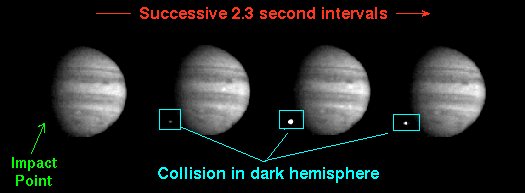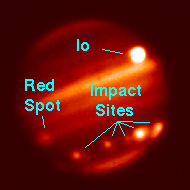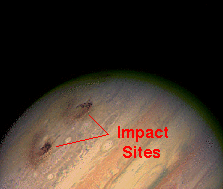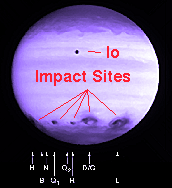 Galileo images: Fragment W of Comet Shoemaker-Levy 9 Strikes Jupiter |
Since the orbits of comets sometimes cross the orbits of other bodies in the
Solar System, collisions may occur. At one time it was thought that a
collision of a comet with the Earth would not be a serious matter. We now
believe differently. In fact, there is rather strong evidence that the Earth
was struck by a comet or small asteroid
early in this century, with devastating results.
The Tunguska Event
On the morning of June 30, 1908, in a remote region of central
Siberia, a great blue-white fireball brighter than
the Sun streaked through the sky and exploded while still in the air with a
blinding flash and intense pulse of heat. The explosion was heard 1000 km
away, and it flattened trees radially 30 kilometers out from a central point in
the Stony Tunguska River valley. The resulting pulse of air pressure
circled the Earth twice, and astronomers observed for several nights
afterwards a glowing red haze in the upper atmosphere, though they were not
aware at the time of the cause.
It is estimated that the explosion had the force of a 10-20
megaton hydrogen bomb
and detonated in the atmosphere about 6-8 km above the surface,
which would explain why no crater has ever been found.
The region was so remote that there were few witnesses and presumably little loss of life. As a result, news of the event filtered only slowly to the outside world. Because of the remoteness and the political turmoil of the early part of this century, it was only 1927 when a scientific expedition finally went to investigate the event. Though various fantastic theories have been proposed (the crash of an alien spaceship), the simplest explanation that is consistent with all the data is that the Earth was struck by the head of a small comet or a small rocky asteroid maybe 100 meters in diameter that exploded before striking the ground.
 Galileo images: Fragment W of Comet Shoemaker-Levy 9 Strikes Jupiter |
These four images were taken at intervals of 2 1/3 seconds on July 22, 1994, with Galileo at a range of 238 million kilometers. The first image shows no impact. In the next three images, a point of light appears, brightens, and then fades, seven seconds after the first picture. Only Galileo was able to directly see the impact sites; from the Earth, the collision site was on Jupiter's back side. It is believed that the point of light in this picture shows the effects of the comet fragment entering Jupiter's atmosphere and is not related to the subsequent explosion and fireball (Ref).
The following images are Earth-based observations of the impact sites after they have rotated into view from the Earth.
 IR from Mauna Kea |
 Visible Wavelengths from Hubble |
 UV from Hubble |
The left image (Ref) is taken from the NASA Infrared Telescope Facility, Mauna Kea, Hawaii. The impact due to Fragment Q is to the far right and the R Fragment impact site shows up very brightly to its left. Additional impact sites form a chain of spots behind R (more info). The middle figure (Ref) shows a Hubble Space Telescope color image of the impact sites for fragments G and Q2. The right figure (Ref) shows an ultraviolet image of Jupiter taken by the Wide Field Camera of NASA's Hubble Space Telescope. The spots are very dark in the ultraviolet because a large quantity of dust is being deposited high in Jupiter's stratosphere and the dust absorbs sunlight (more info).